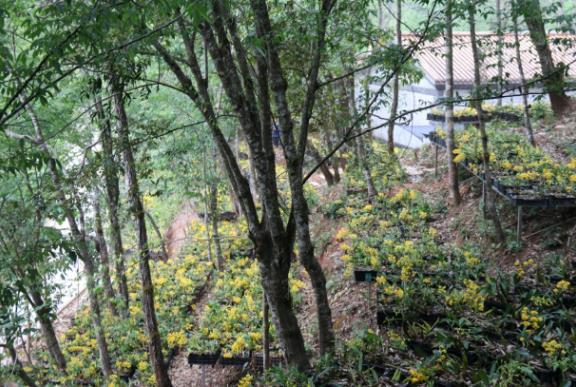Understory planting of epiphytes for ecological and economic enhancement

In China, secondary forests account for half of the forest area and integrated secondary forest management will be of great importance to China or the entire Greater Mekong Sub-region (GMS) in the future. Thus, one objective of the APFNet-funded Integrated Forest Ecosystem Management Planning and Demonstration Project in GMS (Pu'er Project Site, P.R. China) is to establish demonstration plots that showcase the concept of integrated forest ecosystem management and select optimal forest management models based on an evaluation of advanced techniques and best practices.
Based on the natural conditions of the secondary forest at the project site, different silvicultural techniques, such as understory planting, were adopted to increase forest productivity.
Epiphytes are of great significance for sustaining forest ecosystem functions, including maintaining nutrient and water circulation within the forest and increasing biodiversity. Epiphytes – non-parasitic plants living on top of other plants, such as trees – use water vapour in the air and humus accumulated on trees to grow. They are quite sensitive and need good hydrothermal conditions for growth; in this context they serve as natural indicators of environmental changes. This project selected 5 ha of secondary forests with good hydrothermal conditions and convenient access. Dendrobes, Anoectochilus formosanus, Rhizoma bletillae and other Orchidaceae medicinal plants were selected. Of these species, dendrobes fetch an excellent price. Thus, Dendrobium chrysotoxum, Dendrobium aurantiacum, Dendrobium nobile, Dendrobium crepidatum, Dendrobium pendulum, Dendrobium thyrsiflorum, and Dendrobium primulinum were planted at the end of 2017 using local wild seedlings and trunk planting with a density of three to five plants per cluster. Around 4,200 clusters were planted within 1 ha.
Since 2017, two and a half years after planting, the highest net weight of fresh stems was found in D. chrysotoxum (3,777 g/cluster), followed by D. nobile (719 g/cluster) and D. aurantiacum (622 g/cluster). D. pendulum, D. thyrsiflorum, D. primulinum and D. crepidatum had lower production with net weights of 523 g/cluster, 430 g/cluster, 397 g/cluster and 313 g/cluster, respectively.
Based on the natural conditions of the secondary forest at the project site, different silvicultural techniques, such as understory planting, were adopted to increase forest productivity.
Epiphytes are of great significance for sustaining forest ecosystem functions, including maintaining nutrient and water circulation within the forest and increasing biodiversity. Epiphytes – non-parasitic plants living on top of other plants, such as trees – use water vapour in the air and humus accumulated on trees to grow. They are quite sensitive and need good hydrothermal conditions for growth; in this context they serve as natural indicators of environmental changes. This project selected 5 ha of secondary forests with good hydrothermal conditions and convenient access. Dendrobes, Anoectochilus formosanus, Rhizoma bletillae and other Orchidaceae medicinal plants were selected. Of these species, dendrobes fetch an excellent price. Thus, Dendrobium chrysotoxum, Dendrobium aurantiacum, Dendrobium nobile, Dendrobium crepidatum, Dendrobium pendulum, Dendrobium thyrsiflorum, and Dendrobium primulinum were planted at the end of 2017 using local wild seedlings and trunk planting with a density of three to five plants per cluster. Around 4,200 clusters were planted within 1 ha.
Since 2017, two and a half years after planting, the highest net weight of fresh stems was found in D. chrysotoxum (3,777 g/cluster), followed by D. nobile (719 g/cluster) and D. aurantiacum (622 g/cluster). D. pendulum, D. thyrsiflorum, D. primulinum and D. crepidatum had lower production with net weights of 523 g/cluster, 430 g/cluster, 397 g/cluster and 313 g/cluster, respectively.

1. D. chrysotoxum; 2. D. nobile; 3. D. aurantiacum; 4. D. pendulum; 5. D. thyrsiflorum; 6. D. crepidatum; 7. D. primulinum
The current market price for dendrobe fresh stems is CNY 10 per kg for D. chrysotoxum and CNY 15 per kg for other dendrobes. The highest income comes from D. chrysotoxum at USD 23,328 per ha (CNY 10,575.6/mu), followed by D. nobile USD 6,664 per ha, D. aurantiacum USD 5,756 per ha and D. crepidatum USD 2,868 per ha.
Enrichment planting with epiphytes, such as dendrobes, provides non-timber forest products (NTFPs), improves ecosystem service functions and benefits forest ecosystems. It also enables forest farmers to obtain real benefits and improve their livelihoods. In the long term, enrichment planting will prove highly significant in improving forest ecosystem quality in this region and enhancing overall ecological, economic and social conditions.
To learn more about the overall progress of the project “Integrated Forest Ecosystem Management Planning and Demonstration Project in GMS (Pu'er Project Site, P.R. China)” for the period January to June 2020, visit /en/show-model6-987.html (Progress Report 3.5 for this project).
Enrichment planting with epiphytes, such as dendrobes, provides non-timber forest products (NTFPs), improves ecosystem service functions and benefits forest ecosystems. It also enables forest farmers to obtain real benefits and improve their livelihoods. In the long term, enrichment planting will prove highly significant in improving forest ecosystem quality in this region and enhancing overall ecological, economic and social conditions.
To learn more about the overall progress of the project “Integrated Forest Ecosystem Management Planning and Demonstration Project in GMS (Pu'er Project Site, P.R. China)” for the period January to June 2020, visit /en/show-model6-987.html (Progress Report 3.5 for this project).
 |
2020 Midterm Progress Report |



